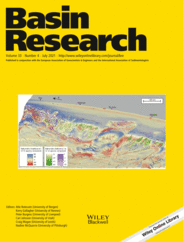
Full text loading...
 , Zhiqian Gao1,2
, Zhiqian Gao1,2 , Tailiang Fan1,2, Yongbin Niu3, Ruixin Guo4
, Tailiang Fan1,2, Yongbin Niu3, Ruixin Guo4
Ultramafic‐derived or magmatic‐sourced fluids transported upward along strike‐slip faults, and contributed to the local precipitation of hydrothermal dolomites and cherts.
Ordovician carbonate rocks on the northern slope of the Tazhong Uplift in the Tarim Basin are modified to varying degrees by hydrothermal fluids related to multiple tectonic‐thermal events, but the nature, origin and circulation mechanisms of such hydrothermal fluids remain debated. In this article, in situ rare‐earth elements and yttrium (REE + Y) concentrations, previously published geochemical datasets and petrographic investigations are integrated to develop a thermo‐tectonic evolution model to improve understanding of silicification and dolomitisation occurring in the interior of the craton basin. δ30Si values, REE + Y ratios and fluid mixing models using modern black smoker fluid and seawater indicate that magma‐sourced hydrothermal fluids, rather than basinal brine heated by magmatism, are responsible for the precipitation of cherts. Petrological and geochemical evidence suggests that deep‐seated, ultramafic‐derived hydrothermal fluids and/or magmatic fluids associated with Permian volcanism may have been involved in the formation of hydrothermal dolomites in the study area. Accompanying formation and reactivation of the strike‐slip faults on the northern slope of the Tazhong Uplift, small volumes of hydrothermal fluids might have been triggered by seismic pumping. The early formed strike‐slip fault systems may also have served as conduits for the subsequent large‐scale transport of deep‐seated, ultramafic‐derived thermal fluids and/or Permian magmatic fluids, along which fluids were transported upwards at high flow rates. Carbonation of ultramafic rocks through interaction with deep‐seated hydrothermal fluids rich in CO2 may have served as a magnesium and silica source for dolomitisation and silicification. Trans‐tensional troughs on NNE‐trending strike‐slip faults with positive flower structure are favourable locations for dolomitisation and silicification.
]
Article metrics loading...

Full text loading...
References


Data & Media loading...

